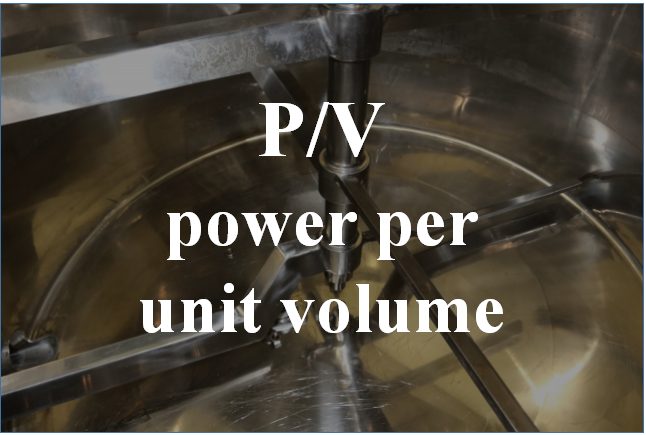Outline
The power required to agitate per unit volume (liquid volume) is called P/V value.
P/V[kW/m3] is expressed by the following equation:
$$P/V=\frac{P}{V}$$
where P is the agitation power, V is the liquid volume.
P/V is often used as an indicator to determine if sufficient power is being applied to the liquid in the mixing vessel.
When evaluated simply by the required agitation power P, the larger the mixing vessel and agitation impeller, the higher the value.
If this is the case, it is impossible to determine whether power is excessive or insufficient.
Therefore, the effect of scale is eliminated by dividing by the liquid volume in the mixing vessel.
P/V Guideline
Below is P/V guideline for each mixing system.
P/V value for each viscosity
Low liquid viscosity:0.1≦P/V≦1.0
High liquid viscosity:1.0≦P/V≦5.0
Low-viscosity liquids that do not require much agitation power are often designed with P/V of 1.0 or less.
P/V of 0.1 or less is unlikely to be selected for a stirred reaction tank because the agitation power is too low and mixing performance is poor. It may be possible in an mixing vessel that does not require uniform mixing.
On the other hand, operating P/V at 1.0 or higher is not recommended because the mixing performance does not change much for the power required.
High viscosity agitation requires more power for agitation, resulting in higher P/V.
When the P/V exceeds 5.0, the liquid is no longer agitated as generally imagined. It will be mixed with a liquid that has properties similar to a solid, such as syrup.
It may no longer be better to use a kneader in that area than to use an mixing vessel.
The P/V is separated by up to 5.0, meaning that liquids that are too viscous are difficult to mix in the mixing vessel.
P/V value for each type of mixing
Liquid-liquid mixing:0.1≦P/V≦2.0
Solid-liquid mixing:0.5≦P/V≦2.0
Gas-liquid mixing:1.0≦P/V≦5.0
For each agitation systems, P/V is a value assuming the liquid is of low viscosity.
As is usual with agitation, it is very difficult to uniformly mix materials with different densities, and power is required.
Liquid-liquid agitation is a relatively easy system for uniform mixing. However, when mixing two phase-separating liquids such as water and oil, it may take up to 1.0 to 2.0 P/V.
Furthermore, it is difficult to achieve completely uniform dispersion.
Solid-liquid agitation depends on the density of solid particles.
If the density of the solid particles is close to the density of the liquid, the P/V is low. The density of polymer particles is often close to the density of the liquid, so not much power is required.
On the other hand, heavier particles such as metals require more energy to lift, so their P/V tends to be higher.
However, it is important to note that if the P/V is set too high, the metal particles are likely to hit the impellers and vessel walls, causing wear or erosion.
Gas-liquid mixing is the most difficult of all multiphase systems.
In solid-liquid mixing, the density difference is a few times at most, but in gas-liquid mixing, the difference is about 1,000 times.
Since the gas will escape upward in a matter of seconds, it is necessary to agitate vigorously to keep as much gas in the liquid as possible.
Also, P/V in gas-liquid mixing depends on the process.
If the gas must be absorbed into the liquid in one pass, the P/V must be set higher.
If some of the gas from the top of the tank is recycled and returned to the feed line, it does not need to be mixed so vigorously.
P/V constant scale-up
P/V is also often used as a criterion in scale-up (or down) considerations.
Scaling up with P/V=constant allows for constant energy to be added per unit liquid volume. As a result, it is easier to obtain similar mixing performance after scale-up.
In particular, scale-up that meets the following three conditions is known to provide the same mixing performance as before scale-up.
- P/V=constant
- Mixing vessel and impeller shape are similar
- Turbulent field with baffles
In conclusion
The P/V value of the required agitation power per unit volume was explained.
This is a basic indicator for agitation tank design, so be sure to keep it in mind.

